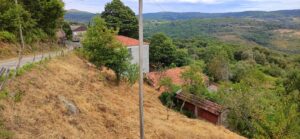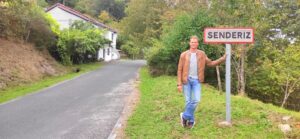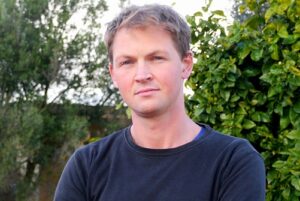It must appear a bit strange when looking at it from the outside: imagine a bunch of people in their 20ies and 30ies in a nice ambiance, sitting there for hours and hours, and you hear – nothing.
Okay, fair enough, we are in a coworking space where work is supposed to happen. And in this particular article we don’t talk about any random coworking space. We talk about a place where people look up from their screens and have a splendid view into a valley right in front of them.
This coworking space is part of the rural coworking and coliving project called “Sende”.

One of the coworking spaces in Sende with the adjacent terrace
The birth of rural coworking and coliving
In fact, Sende is one of the first one of its kind.
The short story goes like this: in 2013, Edo from Serbia and Maria from Spain took a leap of faith and bought the first two houses in a tiny little village in northern Spain bordering with Portugal. And more specifically, they bought them with the dedicated aim to create a rural coworking and coliving project.
A temporary home, a get-away or simply a time-out for remote workers, location independent freelancers or those so-called digital nomads.
Edo and Maria had their focus on a rural coworking and coliving project from the beginning on
When talking about Senderiz, we are looking into a village that has around 20 permanent inhabitants whose average age is beyond 70 years. Neither are there shops, nor a pharmacy, nor any credit card machines. No clubs, no public transport, no artificial smells. You don’t need to carry around any money as there is nowhere you could spend it. No incentives to spend it, to consume.

View on Senderiz downtown
Instead, you find straying cows, nature all around, and when you close your eyes, you will hear – again nothing.
Sende is one of the first rural coworking and coliving projects on the map
You can leave the key in the front door or even leave it completely open – nobody is going to step in here. When I went down in the morning for breakfast I often picked up the bread bags that the only bakery man a few villages further on had delivered sometime in the morning.

This sounds idyllic, right?
Well it actually really is, however, Senderiz is one of thousands of villages all over Europe which are facing some severe issues.
The short version goes like this: because there are no jobs and no ways to earn money in such villages and thus young people have no serious perspectives which makes them moving to the bigger cities. The older people remain and slowly die out. At some point the only local school has to shut down as there are no longer enough kids who would make it worth running the place. Shops and commercial businesses go away, and so do economic opportunities. That makes such villages of course quite unattractive to many people which again pushes them off even more.
I guess you can picture this vicious circle.
No jobs > young people move away > elderlies population slowly decreasing > less and less of economic power > village becomes more unattractive > village gets abandoned

Thanks to Maria’s and Edo’s initiative and effort, Sende has seen more than 3,500 visitors from 50+ nations over the years.
Yes, because of the fast internet connection which has been established and two different coworking spaces that one can choose of, freelancers, digital nomads and whoever not is sitting on his laptop to make a living has found his/her way here.
THE. MOST. IMPORTANT. ELEMENT.
I personally have been in touch with Edo since a couple of years since I was already running my own rural coworking and coliving project, the pilot project Economadia Coworking Farm in northern Portugal, in 2017. That said, it didn’t come as a complete surprise to me what I was going to find out there.
However, the one thing that you can’t predict, the one total unknown variable, is: the community. The kind of people that I was going to meet here during my one month stay in September 2021.

The most important tool in a rural coworking and coliving project: the dining table
It took me a few days to get used to the setting and, well, the people around here. I am always a bit shy in the beginning and rather put on a grim pokerface. Some people might think I’m an arrogant guy then. Well, maybe I even am sometimes.
After the first days I learnt how to get the things I would need for myself, where the storage room is and which garden belonged to which neighbor. I started conversing with some of the elderlies locals of the village.
You slow down, you become more balanced
After about 10 – 14 days it kicked in the feeling of timelessness. Day and night, sun and rain. You get to know to everybody, the rest of the world with its big problems is far away, somewhere else. If I hadn’t seen some neighbors wearing a facemask sometimes I would have completely forgotten about Corona in no time.

Words needed?
Village life
I take my breakfast in the sun while watching the kittens playing. Some old women pass by at our coworking space and greet us. They already know about the young people who, well, sit on their computers for hours without giving any tone from them.
Sure, you shouldn’t be afraid of a bug or spider in your room once in a while or a cow that had her nightly dump in front of your door. Also, while there is a paid cleaning service active every now and then, you shouldn’t be shy to grab the full trash bag once in a while or helping out in the kitchen.
It’s not a hotel where you drop your wet towel in the middle of the room and don’t care about

Dinners are indispensable community events
Dinners are the most important community event of the day normally. And it’s safe to say that one fantastic meal was chasing the next one. Edo was definitely right about that you get served meals that could easily compete with dishes that you would pay 30 or also 50 bucks for in a big city restaurant setting – depends a bit on which city of course.
Needless to say that in a group of about 15 people you get to know to each other reaaaaally well. Personal and also professional connections are happening here, they are almost unavoidable. Future business partners are finding each other here, as well as future couples.

This is how fruitful joint ventures start
And the magic sauce, attention, one more time, is: Sende is a community centered and driven project in contrast to many other coworking and coliving projects which are real estate ventures in the end of the day. This also clearly finds its expression in the moderate pricing for staying here at Sende.
Coworking and coliving projects: community centered vs. real estate ambitions
Simplicity is the key
Maria and Edo are the opposite of complicated. And so is Sende consequently. And it almost took me by surprise that the whole thing works on a daily basis with actually no rules in place.
Sure, a few days before I arrived I had received an email where I got framed. Yeah I think framing is the right term here. No strict rules, no tons of “Don’t” signs, but more agreements, outlining the setting. But other than that it didn’t take much of pushing people to one way or another.

Rrrrrrrrright in front of the coworking space in Sende
The future life in villages?
I am looking around, looking into the valley in front of our coworking space. I am wondering if this is the future. The future village, or at least the beginning of it.
The alternative to the until recently unavoidable city life. Because it is the city where the jobs are (were), where people subsequently moved to and thus life happened. Well, if not before already, since the Covid-19 pandemic we know that this is no longer the unremoveable truth for certain jobs at least.
There is definitely a very good foundation set here. And Edo and Maria had quite a lot of coverage in the media, were invited to a series of different events to present the concept of Sende and they according experiences. Tons of people got inspired (including me) to start a similar project on their own.
The Covid-19 pandemic has revealed that there are realistic alternatives to modern city life
And more importantly than coming up with a blueprint of the perfect and ever-after-happy-people-future-village it’s the signal they are sending out from this small place into the world with this project.

Edo, co-founder of Sende, at a regular working session on his laptop
B-b-but how would you even start?
That is a huge question, in fact the one I am wrapping my head around since a while. And it’s a big one, too. But more than anything else it takes starting doing it. Like so often in life.
Sure, you need or should have some sort of connection to the place where you might potentially want to do it. You don’t randomly walk into a village where you don’t know anyone and don’t have anything, lot less in a foreign country, and start such a project. At least to my very humble experience that makes things much more challenging than they are already.
But hey, if you are really interested in this topic and wish to learn from the master, Edo is not keeping his wisdom to himself. He created the lovely and simultaneously useful knowledge kit “Sende to download”.

Economadia co-founder Jorin in Senderiz, northern Spain
During one of my last days I took my bullet journal (a kind of agenda and personal dairy in one) and wrote down what I know since a long while:
I definitely definitely definitely want to live in a community setting which goes beyond a shared flat situation.
With that said, it becomes one more time clear to me what I have to do.
About the author

Jorin is co-founder of Economadia and loves to write articles for the blog. He’s working online since 2013 and has since then been interested in travel projects and creating great experiences for other people. He used to be a full-blooded backpacker and hitchhiker before he turned more and more into a location independent digital worker.
Read more articles Listen to our podcast Go back to main page
